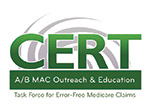October 22, 2014
Insufficient Documentation

This educational guide was developed by the CERT A/B MAC Outreach & Education Task Force to explain the Comprehensive Error Rate Testing (CERT) program and share information with providers on how to provide accurate and supportive medical record documentation.
The Centers for Medicare & Medicaid Services (CMS) implemented the CERT program to measure improper payments in the Medicare Fee-for-Service (FFS) program. Under this program, a random sample of all Medicare FFS claims are reviewed to determine if they were paid properly under Medicare coverage, coding and billing rules. Once the CERT program identifies a claim as part of the sample, it requests the associated medical records and other pertinent documentation from the provider or supplier who submitted the claim via letter. The submitted documentation is then reviewed by medical review professionals to see if the claim was paid or denied appropriately. Providers should submit adequate documentation to ensure that claims are supported as billed.
The collection and review of medical records under the CERT Program is managed by the CERT Documentation Contractor (CERT DC) and the CERT Review Contractor (CERT RC). The CERT DCrequests medical records from providers and suppliers who billed Medicare. The CERT RC reviews selected claims and associated medical records for compliance with Medicare coverage, coding and billing rules. Upon request for a review, it is the billing provider's responsibility to obtain supporting documentation as needed from a referring physician's office (e.g. physician order, notes to support medical necessity) or from an inpatient facility (e.g. progress note). The Medicare Program Integrity Manual (Pub 100-08) Chapter 3 – Section 3.2.3.3 – Third-party Additional Documentation Request![]() states:
states:
The treating physician, another clinician, provider, or supplier should submit the requested documentation. However, because the provider selected for review is the one whose payment is at risk, it is this provider who is ultimately responsible for submitting, within the established timelines, the documentation requested by the MAC, CERT, Recovery Auditor and Zone Program Integrity Contractor (ZPIC).
Claims are determined to have insufficient documentation errors when the medical documentation submitted is inadequate to support payment for the services billed, i.e., the reviewer could not conclude that some of the allowed services were actually provided, were provided at the level billed, and/or were medically necessary. Claims are also placed into this category when a specific documentation element that is required as a condition of payment is missing, such as a physician signature on an order, or a form that is required to be completed in its entirety.
Insufficient documentation errors identified by the CERT Review Contractor may include:
- Incomplete progress notes (e.g., unsigned, undated, insufficient detail, etc.)
- Unauthenticated medical records – no provider signature, no supervising signature, illegible signatures without a signature log or attestation to identify the signer, an electronic signature without the electronic record protocol or policy that documents the process for electronic signatures
- No documentation of intent to order services and procedures – incomplete or missing signed order or progress note describing intent for services to be provided
For your reference, the CERT A/B MAC Outreach & Education Task Force summarizes below descriptions of errors, and links to requirements, for some of the more common procedures that have resulted in insufficient documentation errors:
Vertebral Augmentation Procedures (VAPS):
- Missing signature and date for clinical documentation that supports patient's symptoms – hardcopy physician signature (with signature log if illegible or protocol as above if electronic).
- No evidentiary radiographs performed to support medical necessity of procedure.
- Insufficient medical record documentation supporting that conservative medical management was tried and failed (e.g. medication administration records, therapy discharge summary) or was contraindicated.
- No signed and dated attestation statement for the operative report if a physician signature was missing or illegible. If the operative report is electronically signed, the protocol should also be submitted.
Vertebral Augmentation Procedures References:
- Centers for Medicare and Medicaid Services (CMS) Internet Only Manual (IOM) 100-8, Chapter 3 Section 3.3.2.4 – Signature requirements

- The Medicare Coverage Database (MCD)
 for Local Coverage Determinations (LCDs) on Vertebral Augmentation Procedures (VAPs) serving your specific MAC.
for Local Coverage Determinations (LCDs) on Vertebral Augmentation Procedures (VAPs) serving your specific MAC.
Physical Therapy (PT) Services:
- Documentation did not support certification of the plan of care for physical therapy services. The physician's/non-physician practitioner's (NPP) signature and date of certification of the plan of care or progress note indicating the physician/NPP reviewed and approved the plan of care is required.
Physical Therapy References:
- CMS Internet Only Manual Publication 100-2, Benefit Policy Manual, Chapter 15 Section 220.1.1(A) – Outpatient Therapy Must be Under the Care of a Physician/Nonphysician Practitioners (NPP) (Orders/Referrals and Need for Care)

- Section 220.1.3 – Certification and Recertification of Need for Treatment and Therapy Plans of Care

- CMS Internet Only Manual Publication 100-2, Benefit Policy Manual, Chapter 15, Section 220.4 – Functional Reporting

Evaluation and Management (E&M) Services:
- E&M services for Office Visits Established, Hospital Initial and Hospital Subsequent were identified as the top three CERT errors in E&M services categories. High errors consisted of insufficient documentation, no documentation, and incorrect coding of E&M services to support medical necessity and accurate billing of E&M services.
Evaluation and Management References:
- CMS Internet Only Manual – Publication 100-04 – Claims Processing Manual Pub Chapter 12 Section 30.6 – Evaluation and Management Service Codes – General (Codes 99201 – 99499)

- Program Integrity Manual Pub 100-8, Chapter 3 Section 3.3.2.4 – Signature Requirements

Durable Medical Equipment (DME):
- Effective July 1, 2013, certain DME HCPCS codes (i.e., hospital beds, glucose monitors, and manual wheelchairs) require a valid detailed written order prior to delivery per MLN Matters MM8304.
The physician's NPI must be on the valid detailed written order.
Computed Tomography (CT scans):
- Documentation of the plan or intent to order computed tomography (CT scan) was insufficient to support medical necessity. If the handwritten signature is illegible, include a signature log, and if electronic, the protocol should also be submitted.
Computed Tomography References:
- CMS Internet Only Manual – Publication 100-2 Benefit Policy Manual, Chapter 15 Section 80.6.1(A) Requirements for Ordering and Following Orders for Diagnostic Tests

- Program Integrity Manual Pub 100-8, Chapter 3 Section 3.3.2.4 – Signature Requirements

The CERT A/B MAC Provider Outreach & Education Task Force is focused on education to reduce CERT errors. Visit the CMS CERT web page![]() to review information on the CERT 101 presentation, Improper Payments Reports, CMS Fact sheets and more helpful tips.
to review information on the CERT 101 presentation, Improper Payments Reports, CMS Fact sheets and more helpful tips.
Disclaimer: Comprehensive Error Rate Testing (CERT) Part A and Part B (A/B) Medicare Administrative Contractor (MAC) Outreach & Education Task Force is independent from the Centers for Medicare & Medicaid Services (CMS) CERT team and CERT contractors, which are responsible for calculation of the Medicare fee-for-service improper payment rate.


